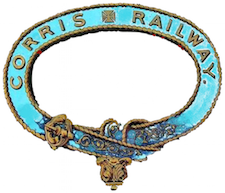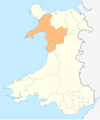
The Corris Railway is a narrow gauge railway based in Corris on the border between Merionethshire and Montgomeryshire in Mid-Wales.

The Talyllyn Railway is a narrow-gauge railway in Wales running for 7+1⁄4 miles (12 km) from Tywyn on the Mid-Wales coast to Nant Gwernol near the village of Abergynolwyn. The line was opened in 1865 to carry slate from the quarries at Bryn Eglwys to Tywyn, and was the first narrow gauge railway in Britain authorised by Act of Parliament to carry passengers using steam haulage. Despite severe underinvestment, the line remained open, and in 1951 it became the first railway in the world to be preserved as a heritage railway by volunteers.

The Narrow Gauge Railway Museum is a purpose-built museum dedicated to narrow-gauge railways situated at the Tywyn Wharf station of the Talyllyn Railway in Tywyn, Gwynedd, Wales.

Sir Henry Haydn Jones was a Welsh Liberal Party politician.

Abergynolwyn is a village in southern Gwynedd, Wales, located at the confluence of the Nant Gwernol and the Afon Dysynni. The population of the community which is named after the village of Llanfihangel-y-Pennant was 339 at the 2011 census.
The Plynlimon and Hafan Tramway was a 2 ft 3 in gauge narrow gauge railway in Cardiganshire in Mid Wales. It ran from Llanfihangel station on the Cambrian Line, through the village of Tal-y-bont and the valley of the Afon Leri, into the foothills of Plynlimon Fawr. It was built to serve the lead mines at Bwlch Glas and stone quarries around Hafan and opened in 1897, closing just two years later. The line was a little over 7 miles (11 km) long and, despite running a short-lived passenger service, it served no communities of more than 100 people.

Tywyn railway station serves the town of Tywyn in Gwynedd, Wales. The station is on the Cambrian Coast Line, with passenger services to Barmouth, Harlech, Porthmadog, Pwllheli, Aberdovey, Machynlleth and Shrewsbury.

Bryn Eglwys quarry was a slate quarry and mine near Abergynolwyn, in Merionethshire, Wales. More than 300 men worked at the site, making it the principal employer in the area. Two veins of slate, known as the Broad Vein and the Narrow Vein, were worked. The geology continues eastwards towards Corris and Dinas Mawddwy, and westwards towards Tywyn. It was one of many quarries that worked these veins.

Tywyn Wharf railway station is the western terminus and principal station of the Talyllyn Railway in Tywyn, Gwynedd in mid-Wales.

Pendre railway station is a station on the Talyllyn Railway in Tywyn, Gwynedd in mid-Wales. It is 0.42 miles (0.68 km) from Tywyn Wharf, which is the primary station and western terminus of the railway. Pendre is the site of the railway's locomotive and carriage sheds, and engineering works. Passenger trains stop at Pendre by request only.

Brynglas railway station is a request stop on the Talyllyn Railway, serving the hamlet of Pandy near Bryn-crug, in Gwynedd, Mid-Wales. It is 3.17 miles (5.10 km) from Tywyn Wharf. A station building and platform are provided on the north side of the track, as the railway's carriages have been modified to have doors only on this side for safety reasons. The station building is a Grade II listed structure.

Dolgoch railway station is a station on the Talyllyn Railway between Tywyn and Abergynolwyn, Gwynedd in north-Wales. It is 4 miles 72 chains from Tywyn Wharf. Unlike most places on the line, the station was built for tourist traffic, for visitors to the local Dolgoch Falls.

Abergynolwyn railway station is a station on the Talyllyn Railway near Abergynolwyn, Gwynedd, in Mid-Wales. It is 6.55 miles (10.54 km) from Tywyn Wharf. The name 'Abergynolwyn' means 'Mouth-of-the-River-with-a-Whirlpool'.

Nant Gwernol railway station is the eastern terminus of the Talyllyn Railway near Abergynolwyn, Gwynedd in mid-Wales. It is 7 miles, 28 chains (11.83 km) from Tywyn Wharf. Nant Gwernol station was opened in 1976; before 1976 this upper part of the line had only been used for goods services.

Sir Haydn is a narrow gauge steam locomotive, built by Hughes's Locomotive & Tramway Engine Works, Loughborough in 1878. It operated on the Corris Railway in Wales, until closure in 1948, and since 1951 has operated on the nearby Talyllyn Railway. It has carried the operating number 3 under four successive owners.

Edward Thomas is a narrow gauge steam locomotive. Built by Kerr Stuart & Co. Ltd. at the California Works, Stoke-on-Trent in 1921, it was delivered new to the Corris Railway where it ran until 1948. After that railway closed, the locomotive was brought to the Talyllyn Railway in 1951, then restored, and remains in working order at the heritage railway. It has carried the operating number 4 under four successive owners.

Dolgoch slate quarry was a slate quarry in Mid Wales, approximately halfway between Bryn-crug and Abergynolwyn. The quarry was named after a nearby stream, the Nant Dolgoch. 'Dol goch' is Welsh for 'red meadow'.
Railway with a Heart of Gold is a 1965 short documentary film about the Talyllyn Railway in Mid-Wales, filmed by American filmmaker Kit Davidson. Filmed in 1953, it portrays the operation of the railway and experiences of the volunteers in the early years of its preservation.


















